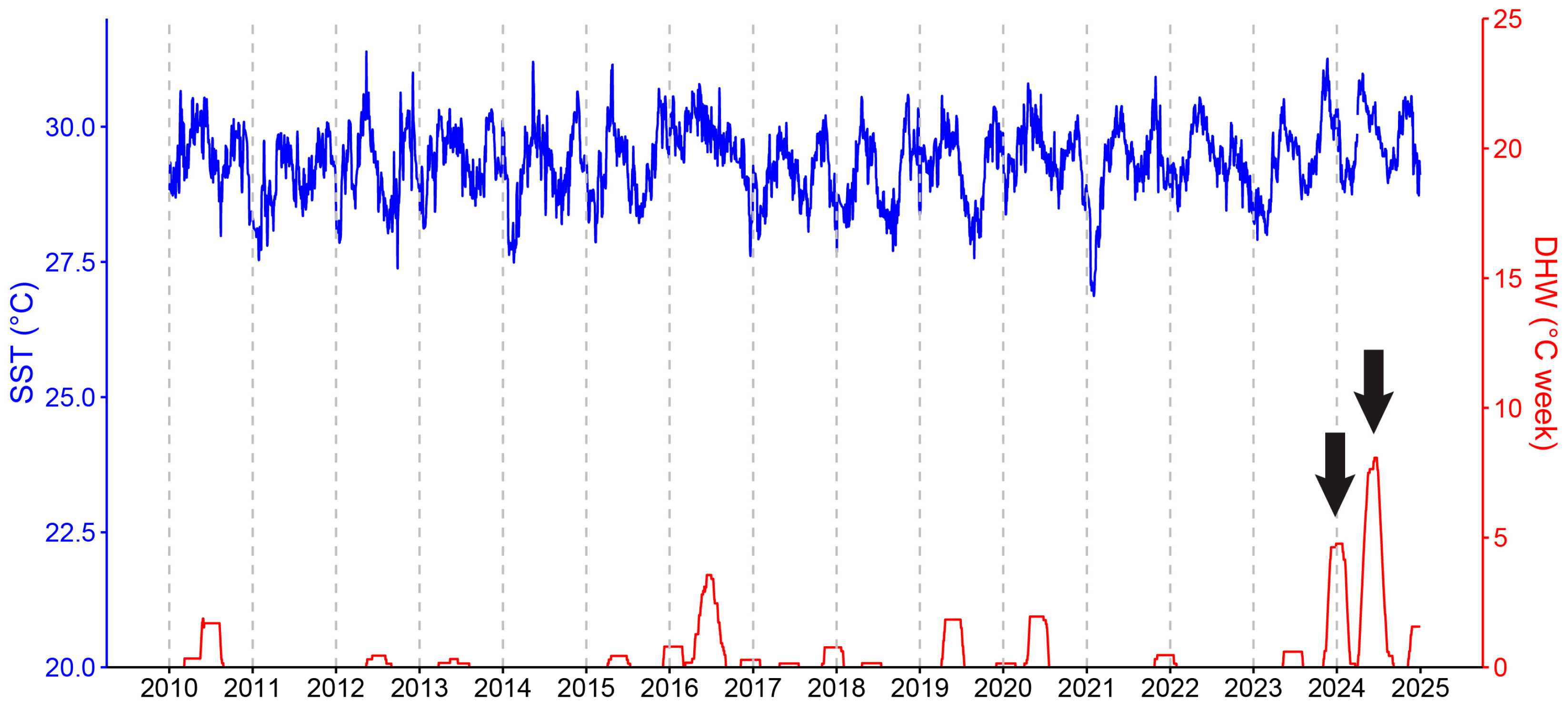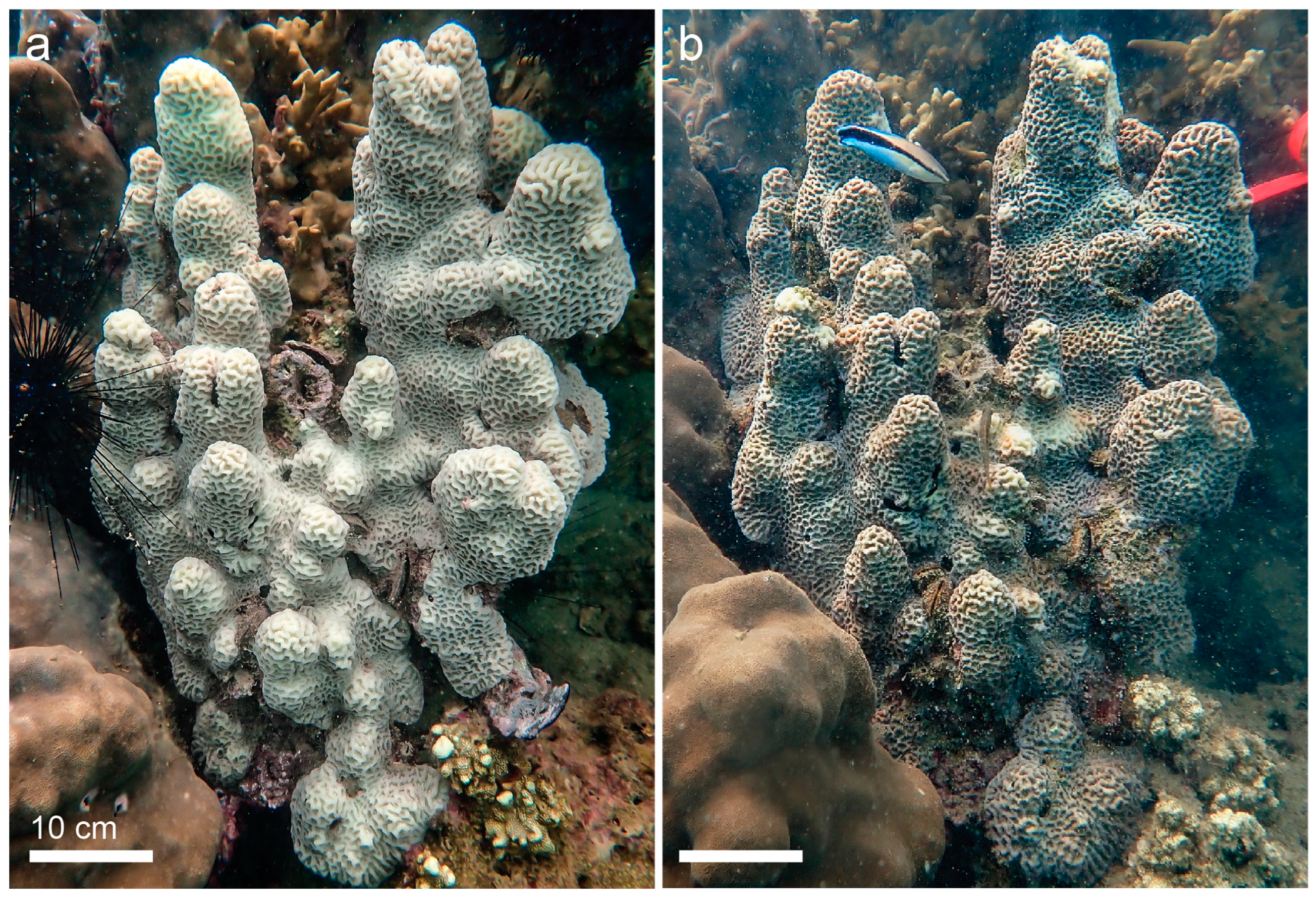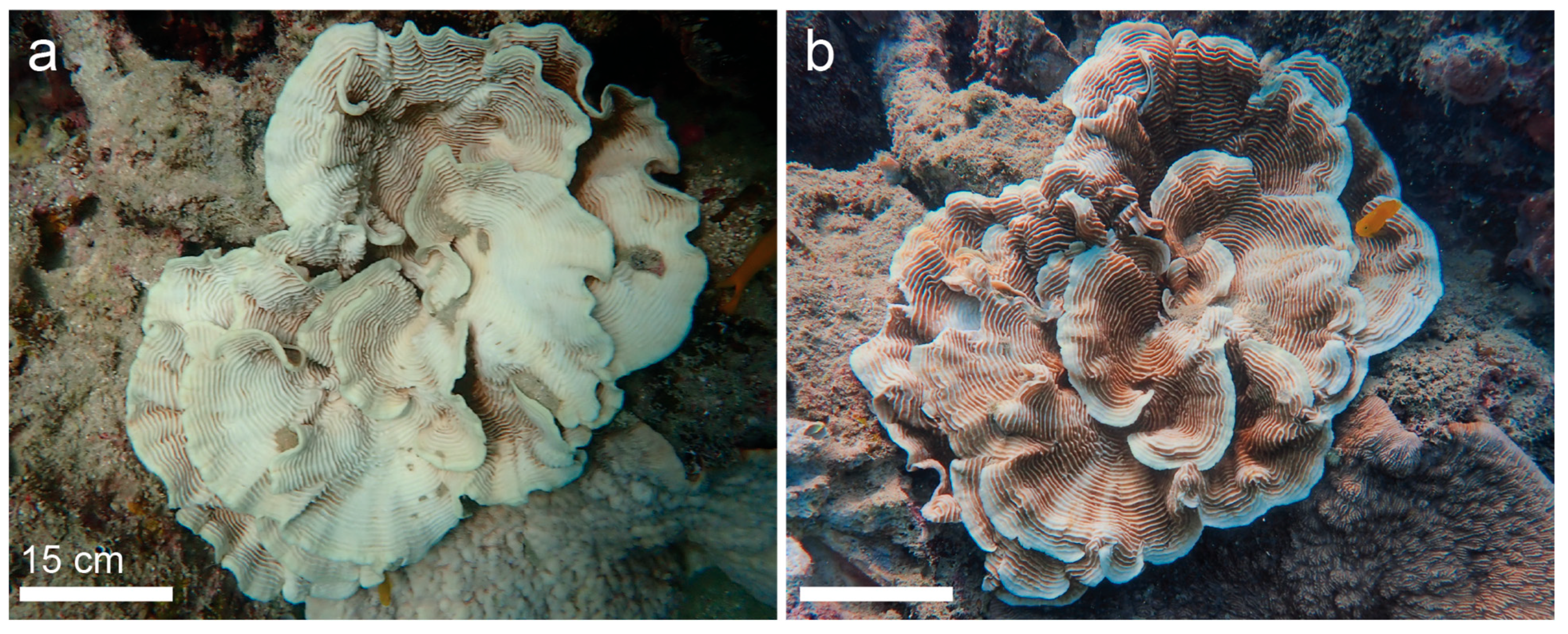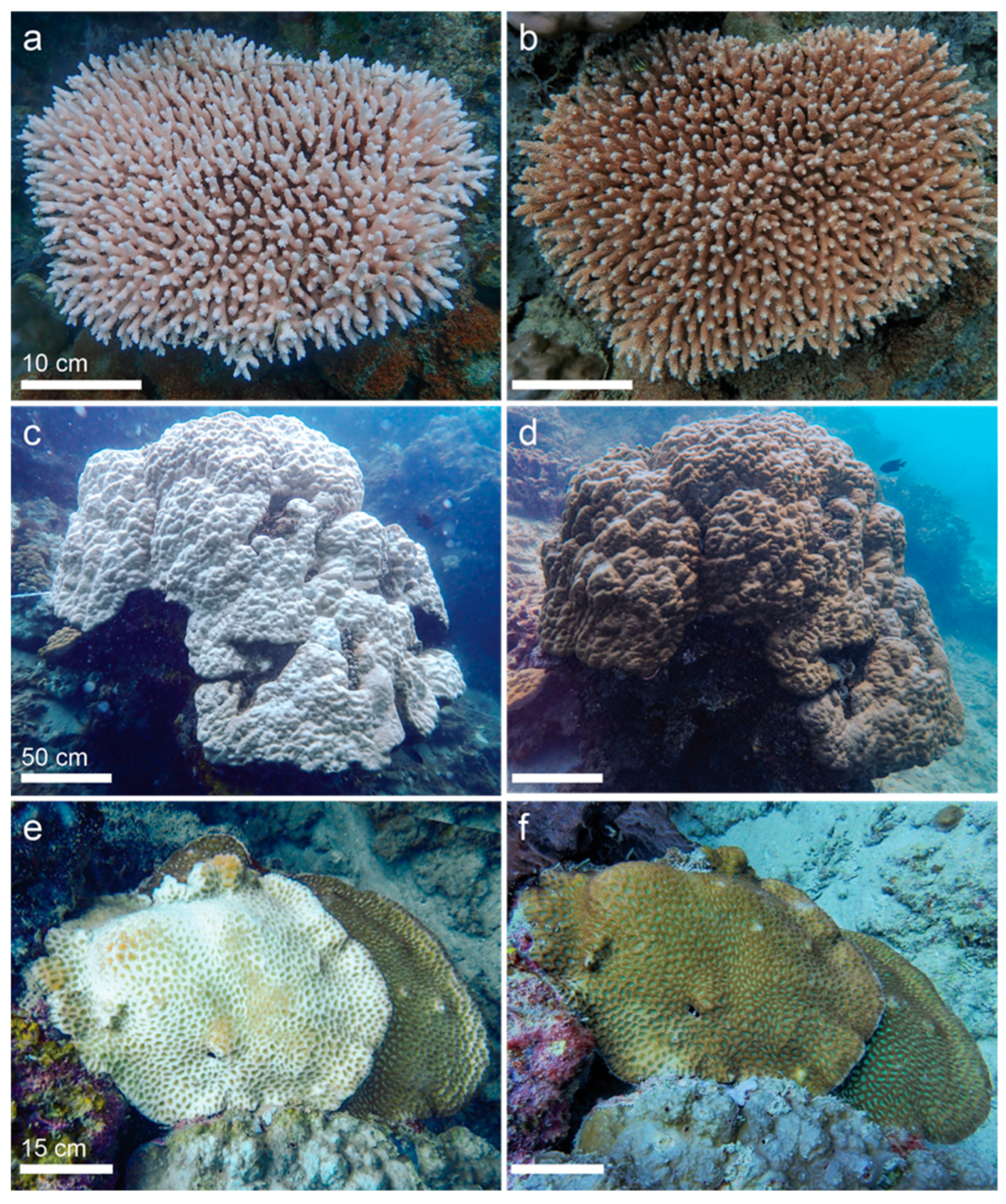Coral Bleaching and Recovery on Urban Reefs off Jakarta, Indonesia, During the 2023–2024 Thermal Stress Event
Abstract
Author Contributions
Funding
Institutional Review Board Statement
Data Availability Statement
Acknowledgments
Conflicts of Interest
References
- van der Meij, S.E.T.; Suharsono; Hoeksema, B.W. Long-term changes in coral assemblages under natural and anthropogenic stress in Jakarta Bay (1920–2005). Mar. Pollut. Bull. 2010, 60, 1442–1454. [Google Scholar] [CrossRef]
- Cleary, D.F.R.; Polónia, A.R.M.; Renema, W.; Hoeksema, B.W.; Wolstenholme, J.; Tuti, Y.; de Voogd, N.J. Coral reefs next to a major conurbation: A study of temporal change (1985–2011) in coral cover and composition in the reefs of Jakarta, Indonesia. Mar. Ecol. Prog. Ser. 2014, 501, 89–98. [Google Scholar] [CrossRef]
- Baum, G.; Januar, H.I.; Ferse, S.C.A.; Kunzmann, A. Local and regional impacts of pollution on coral reefs along the Thousand Islands north of the megacity Jakarta, Indonesia. PLoS ONE 2015, 10, e0138271. [Google Scholar] [CrossRef]
- Badan Pusat Statistik Provinsi DKI Jakarta. Jumlah penduduk menurut kabupaten/kota di Provinsi DKI Jakarta (jiwa), 2022–2023. Available online: https://jakarta.bps.go.id (accessed on 10 May 2025).
- Bengen, D.G.; Knight, M.; Dutton, I. Managing the port of Jakarta Bay: Overcoming the legacy of 400 years of adhoc development. In The Environment in Asia Pacific Harbours; Wolanski, E., Ed.; Springer: Dordrecht, The Netherlands, 2006; pp. 413–431. [Google Scholar]
- Lestari, P.; Trihadiningrum, Y. The impact of improper solid waste management on plastic pollution in the Indonesian coastal and marine environment. Mar. Pollut. Bull. 2019, 149, 110505. [Google Scholar] [CrossRef] [PubMed]
- Sudirman, N.; Suryono, D.D.; Daulat, A.; Rustam, A.; Salim, H.L.; Jayawiguna, M.H. Distribution of marine debris in Jakarta Bay and its implication to the coastal ecosystem. IOP Conf. Ser. Earth Environ. Sci. 2021, 925, 012017. [Google Scholar] [CrossRef]
- Kunzmann, A.; Schwarzbauer, J.; Palm, H.W.; Damriyasa, M.; Yulianto, I.; Kleinertz, S.; Oetam, V.S.P.; Abdul-Aziz, M.A.; Mrotzek, G.; Haryanti, H.; et al. Impact of megacities on the pollution of coastal areas—The case example Jakarta Bay. In Science for the Protection of Indonesian Coastal Ecosystems (SPICE); Elsevier: Amsterdam, The Netherlands, 2022; pp. 285–346. [Google Scholar]
- Hoegh-Guldberg, O.; Skirving, W.; Dove, S.G.; Spady, B.L.; Norrie, A.; Geiger, E.F.; Liu, G.; De La Cour, J.L.; Manzello, D.P. Coral reefs in peril in a record-breaking year. Science 2023, 382, 1238–1240. [Google Scholar] [CrossRef] [PubMed]
- Reimer, J.D.; Peixoto, R.S.; Davies, S.W.; Traylor-Knowles, N.; Short, M.L.; Cabral-Tena, R.A.; Burt, J.A.; Pessoa, I.; Banaszak, A.T.; Winters, R.S.; et al. The fourth global coral bleaching event: Where do we go from here? Coral Reefs 2024, 43, 1121–1125. [Google Scholar] [CrossRef]
- Quigley, K.M.; Baird, A.H. Future climate warming threatens coral reef function on World Heritage reefs. Glob. Change Biol. 2024, 30, e17407. [Google Scholar] [CrossRef]
- Brown, B.E. Worldwide death of corals—Natural cyclical events or man-made pollution? Mar. Pollut. Bull. 1987, 18, 9–13. [Google Scholar] [CrossRef]
- Brown, B.E.; Suharsono. Damage and recovery of coral reefs affected by El Niño related seawater warming in the Thousand Islands, Indonesia. Coral Reefs 1990, 8, 163–170. [Google Scholar] [CrossRef]
- Hoeksema, B.W. Control of bleaching in mushroom coral populations (Scleractinia, Fungiidae) in the Java Sea: Stress tolerance and interference by life history strategy. Mar. Ecol. Prog. Ser. 1991, 74, 225–237. [Google Scholar] [CrossRef]
- Bachtiar, I.; Hadi, T.A. Differential impacts of 2016 coral bleaching on coral reef benthic communities at Sekotong Bay, Lombok Barat, Indonesia. Biodiversitas J. Biol. Divers. 2019, 20, 570–575. [Google Scholar] [CrossRef]
- Corvianawatie, C.; Abrar, M.; Wouthuyzen, S.; Darmawan; Kusumo, S.; Samsuardi; Yennafri; Salatalohi, A.; Hanif, A.; Permana, S.; et al. The ocean atmospheric condition around Pieh Islands–Western Sumatra, Indonesia, and its role on coral reef resilience. IOP Conf. Ser. Earth Environ. Sci. 2018, 200, 012063. [Google Scholar] [CrossRef]
- Guest, J.R.; Baird, A.H.; Maynard, J.A.; Muttaqin, E.; Edwards, A.J.; Campbell, S.J.; Yewdall, K.; Affendi, Y.A.; Chou, L.M.; Matz, M.V. Contrasting patterns of coral bleaching susceptibility in 2010 suggest an adaptive response to thermal stress. PLoS ONE 2012, 7, e33353. [Google Scholar] [CrossRef]
- Tun, K.; Chou, L.M.; Low, J.; Yeemin, T.; Phongsuwan, N.; Setiasih, N.; Wilson, J.; Amri, A.Y.; Adzis, K.A.A.; Lane, D.; et al. A regional overview on the 2010 coral bleaching event in Southeast Asia. In Status of Coral Reefs in East Asian Seas Region 2010; Ministry of the Environment, Ed.; Ministry of the Environment: Tokyo, Japan, 2010; Volume 9. [Google Scholar]
- Wouthuyzen, S.; Abrar, M.; Lorwens, J. A comparison between the 2010 and 2016 El Niño induced coral bleaching in the Indonesian waters. IOP Conf. Ser. Earth Environ. Sci. 2018, 118, 012051. [Google Scholar] [CrossRef]
- Yusuf, S.; Jompa, J. First quantitative assessment of coral bleaching on Indonesian reefs. In Proceedings of the 12th International Coral Reef Symposium, Cairns, Australia, 9–13 July 2012; p. 17D:6. [Google Scholar]
- Ampou, E.E.; Johan, O.; Menkes, C.E.; Niño, F.; Birol, F.; Ouillon, S.; Andréfouët, S. Coral mortality induced by the 2015–2016 El Niño in Indonesia: The effect of rapid sea level fall. Biogeosciences 2017, 14, 817–826. [Google Scholar] [CrossRef]
- Eakin, C.M.; Sweatman, H.P.; Brainard, R.E. The 2014–2017 global-scale coral bleaching event: Insights and impacts. Coral Reefs 2019, 38, 539–545. [Google Scholar] [CrossRef]
- Wilson, J.; Ardiwijaya, R.; Prasetia, R. A Study of the Impact of the 2010 Coral Bleaching Event on Coral Communities in Wakatobi National Park; The Nature Conservancy: Jakarta, Indonesia, 2012. [Google Scholar]
- Ahmadia, G.N.; Awaludinnoer; Glew, L.; Pakiding, F.; Harris, J.; Hidayat, N.; Ihsan, E.; Mascia, M.B.; Matualage, D.; Mohebalian, P.; et al. State of the Bird’s Head Seascape MPA Network Report; World Wildlife Fund, Conservation International, The Nature Conservancy, Universitas Papua: Jakarta, Indonesia, 2016. [Google Scholar]
- Kayanne, H. Validation of degree heating weeks as a coral bleaching index in the northwestern Pacific. Coral Reefs 2017, 36, 63–70. [Google Scholar] [CrossRef]
- Liu, G.; Eakin, C.M.; Chen, M.; Kumar, A.; De La Cour, J.L.; Heron, S.F.; Geiger, E.F.; Skirving, W.J.; Tirak, K.V.; Strong, A.E. Predicting heat stress to inform reef management: NOAA Coral Reef Watch’s 4-month coral bleaching outlook. Front. Mar. Sci. 2018, 5, 57. [Google Scholar] [CrossRef]
- Castillo, K.D.; Lima, F.P. Comparison of in situ and satellite-derived (MODIS-Aqua/Terra) sea surface temperatures: Implications for coral reef studies. J. Exp. Mar. Biol. Ecol. 2010, 383, 167–173. [Google Scholar] [CrossRef]
- de Oliveira, M.D.; Costa, M.B.S.F.; Güntner, A. Spatial-temporal reliability of satellite-derived temperature and thermal stress in the Abrolhos Bank, Brazil. Remote Sens. Appl. Soc. Environ. 2022, 25, 100706. [Google Scholar] [CrossRef]
- Margaritis, G.; Kent, E.C.; Foster, G.L. Intercomparison of satellite-derived SST with logger data in the Caribbean—Implications for coral reef monitoring. PLoS Clim. 2025, 4, e0000480. [Google Scholar] [CrossRef]
- NOAA Coral Reef Watch. Daily global 5-km satellite coral bleaching heat stress monitoring product suite, version 3.1. National Oceanic and Atmospheric Administration (NOAA) Coral Reef Watch (CRW). 2025. Available online: https://coralreefwatch.noaa.gov/product/5km/ (accessed on 28 June 2025).
- Suryadjaja, R.; Astuti, W. Small island settlement planning in Panggang Island, DKI Jakarta. IOP Conf. Ser. Earth Environ. Sci. 2021, 940, 012012. [Google Scholar] [CrossRef]
- Muir, P.R.; Done, T.; Aguirre, J.D. High regional and intrageneric variation in susceptibility to mass bleaching in Indo-Pacific coral species. Glob. Ecol. Biogeogr. 2021, 30, 1889–1898. [Google Scholar] [CrossRef]
- Burn, D.; Hoey, A.S.; Matthews, S.; Harrison, H.B.; Pratchett, M.S. Differential bleaching susceptibility among coral taxa and colony sizes, relative to bleaching severity across Australia’s Great Barrier Reef and Coral Sea Marine Parks. Mar. Pollut. Bull. 2023, 191, 114907. [Google Scholar] [CrossRef] [PubMed]
- Doherty, M.L.; Johnson, J.V.; Goodbody-Gringley, G. Widespread coral bleaching and mass mortality during the 2023–2024 marine heatwave in Little Cayman. PLoS ONE 2025, 20, e0322636. [Google Scholar] [CrossRef]
- Guest, J.R.; Tun, K.; Low, J.; Vergés, A.; Marzinelli, E.M.; Campbell, A.H.; Bauman, A.G.; Feary, D.A.; Chou, L.M.; Steinberg, P.D. 27 years of benthic and coral community dynamics on turbid, highly urbanised reefs off Singapore. Sci. Rep. 2016, 6, 36260. [Google Scholar] [CrossRef]
- Ng, C.S.L.; Huang, D.; Ben Toh, K.; Sam, S.Q.; Kikuzawa, Y.P.; Toh, T.C.; Taira, D.; Chan, Y.K.S.; Hung, L.Z.T.; Sim, W.T.; et al. Responses of urban reef corals during the 2016 mass bleaching event. Mar. Pollut. Bull. 2020, 154, 111111. [Google Scholar] [CrossRef]
- Rosedy, A.; Ives, I.; Waheed, Z.; Hussein, M.A.S.; Sosdian, S.; Johnson, K.; Santodomingo, N. Turbid reefs experience lower coral bleaching effects in NE Borneo (Sabah, Malaysia). Reg. Stud. Mar. Sci. 2023, 68, 103268. [Google Scholar] [CrossRef]
- Heery, E.C.; Hoeksema, B.W.; Browne, N.K.; Reimer, J.D.; Ang, P.O.; Huang, D.; Friess, D.A.; Chou, L.M.; Loke, L.H.; Saksena-Taylor, P.; et al. Urban coral reefs: Degradation and resilience of hard coral assemblages in coastal cities of East and Southeast Asia. Mar. Pollut. Bull. 2018, 135, 654–681. [Google Scholar] [CrossRef]






Disclaimer/Publisher’s Note: The statements, opinions and data contained in all publications are solely those of the individual author(s) and contributor(s) and not of MDPI and/or the editor(s). MDPI and/or the editor(s) disclaim responsibility for any injury to people or property resulting from any ideas, methods, instructions or products referred to in the content. |
© 2025 by the authors. Licensee MDPI, Basel, Switzerland. This article is an open access article distributed under the terms and conditions of the Creative Commons Attribution (CC BY) license (https://creativecommons.org/licenses/by/4.0/).
Share and Cite
Razak, T.B.; Irhas, M.; Nikita, L.; Vida, R.T.; Maserati, S.; Alisa, C.A.G. Coral Bleaching and Recovery on Urban Reefs off Jakarta, Indonesia, During the 2023–2024 Thermal Stress Event. Diversity 2025, 17, 540. https://doi.org/10.3390/d17080540
Razak TB, Irhas M, Nikita L, Vida RT, Maserati S, Alisa CAG. Coral Bleaching and Recovery on Urban Reefs off Jakarta, Indonesia, During the 2023–2024 Thermal Stress Event. Diversity. 2025; 17(8):540. https://doi.org/10.3390/d17080540
Chicago/Turabian StyleRazak, Tries B., Muhammad Irhas, Laura Nikita, Rindah Talitha Vida, Sera Maserati, and Cut Aja Gita Alisa. 2025. "Coral Bleaching and Recovery on Urban Reefs off Jakarta, Indonesia, During the 2023–2024 Thermal Stress Event" Diversity 17, no. 8: 540. https://doi.org/10.3390/d17080540
APA StyleRazak, T. B., Irhas, M., Nikita, L., Vida, R. T., Maserati, S., & Alisa, C. A. G. (2025). Coral Bleaching and Recovery on Urban Reefs off Jakarta, Indonesia, During the 2023–2024 Thermal Stress Event. Diversity, 17(8), 540. https://doi.org/10.3390/d17080540





